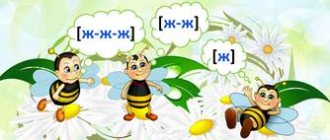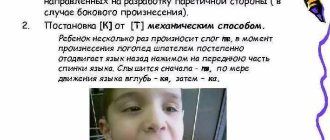Literacy training “Sounds [n], [n`] and the letter N”
Guess the riddle:
On a piece of paper, on a page - Either dots or birds. Everyone is sitting on the ladder and singing songs.
That's right, these are notes. Say the word.
- How many vowels do we hear? So how many syllables are there in a word? Which syllable is stressed?
Say 1 syllable. What sound do we hear at the beginning? What is he like? Do you know the notes?
But our online lesson is dedicated to the sound [n] . We found out that the consonant is voiced and hard. But, wait a minute... Another riddle...
He wears his horns like a royal crown. Eats lichen and green moss. Loves snowy meadows. ( Deer )
What sound do you hear at the end of the word "deer"? Is it a vowel or a consonant? Hard or soft?
This means that there are two sounds [n] , [n']. We will talk about them further.
1. Repeat the syllables.
| On - but - well - us | An - he - un |
| We - on - well - but | Eun - he - un |
| But - we - well - on | Un - an - he |
| Well - on - us - but | He - un - eun |
| On - on | Well - but |
| But - on | Well - we |
| But - well | We - well |
2. Come up with words that begin with the sounds [n] , [n'].
And here is the rhinoceros. Do you know why the animal was named that way? Why does he have a horn on his nose?
Do you know that there are many phraseological units with the word “nose”...
To hack on the nose - remember To hang one's nose - To turn up one's nose - to be arrogant one by the nose - to deceive To speak under - to speak quietly from under one's nose - to steal from a prominent place From a gingerly nose - very little To stick one's nose - to appear The nose has not grown - it is still small Poke under your nose - pester Wipe your nose - prove Poke with your nose - interfere Poke your nose - do delving into Poke your nose - incriminate A mosquito will not undermine your nose - very accurate
In pairs, come up with dialogues where it would be appropriate to use one of the phraseological units.
3. Listen to G. Yudin’s story “Pinocchio’s Nose” and try to remember as many words as possible that start with the sound [n] or [n`]
Pinocchio Nose
For the New Year, the children in kindergarten had to dress up as someone. Nikita decided to make himself a long nose and paint his cheeks, as if he were Pinocchio.
Nikita sat down on the floor, cut the paper with scissors, smeared it with glue and rolled it into a tube. I looked, and it wasn’t a nose, but a whole nose.
“I’m tired of making this Pinocchio nose,” Nikita mutters, “I’d rather tie it to my head with threads and be a rhinoceros.”
I started winding the threads. I reeled and reeled - nothing worked! Nikita pouted.
- I'll stick it directly on my head. I smeared glue on my head and applied my nose. My hair was stuck together and my nose had fallen to one side.
- I'm tired of this rhinoceros. It’s better to come after the New Year and say that I was dressed as invisible, that’s why they didn’t see me. Well, now for practical material: literary words, games, crosswords, puzzles, charades starting with the letter N.
4. Game “Name the antonyms”
Left - (right), high - (low), under - (above), upper - (lower), dry - (wet).
5. Game “Choose a word”
- Put on - (dress, stockings, fur coat, raincoat, skirt).
- Draw – (picture, drawing, boat).
6. Game “Syllable Auction”
- Add other syllables to the syllable “na” so that you get new words: na... (-sos, -genus, -weight).
- To the syllable “but” add other syllables so that you get new words: but... (-chi, -zhi, -ra).
7. Game “Syllable Lotto”. Think of children's names in which the syllable “na” would be the second syllable in the word.
Answer: Nina, Lena, Lina, Gena, Tina, Rina, Zina, Dina.
The hard consonant sound [n] and the soft consonant sound [n'] are indicated in writing by one letter. It is called the letter "en". Meet the letter N in a sock!
What does the letter N ?
1. Look carefully at the letters, find similarities and differences.
2 . Find the hidden letters H. Circle them.
3. Trace and color only those balls on which the letter H . Connect them with strings with Dunno.
4. Color the large letter blue and the small letter green on the left side of the picture. Shade the letter according to the example. Find and color the letter H on the right side of the picture.
5. Connect with the letter N only those objects whose names begin with the sounds [n] , [n`]
6. Draw the second half of the letter H on the left. Circle all the H's on the right.
7. Game “Name the antonyms”
Left - (right), high - (low), under - (above), upper - (lower), dry - (wet).
8. Game “Choose a word”
- Put on - (dress, stockings, fur coat, raincoat, skirt).
- Draw – (picture, drawing, boat).
9. Game “Magic chain”
- Replace one letter with the letter “n” in the words: ice - flax, syllable - elephant, juice - dream, cheese - son, frame - wound, puddle - moon, salki - sled, village - hay.
- How to make day out of night?
Night - zero - salt - solo - village - hay - canopy - net - child - day.
10. I gram “Anagrams”
Pump (pine), roll (rope), norma (romance), spout (socks), nochka (head of cabbage), glow (channel), nickel (spruce forest), mute (coin), mink (crown).
11. Reading...
12. We are writing...
Learn to write beautifully here
13.
Dictionary
- A tax is a mandatory payment to the state.
- Parting words are words, wishes for someone setting off on a journey, or advice for the future.
- People are the population of a certain country.
- An innovator is a person who introduces and implements new ideas.
I recommend reading:
- 77 Effective Educational Techniques
- Mathematics Olympiad (2nd grade)
- What should a child know in 1st grade?
- Cheat sheet for parents. Literacy training.
Tags: Internet Russian language
What are voiced consonants?
Our speech consists of segments that are complete in meaning and intonation, which are called sentences. Each sentence is made up of individual words, and words in turn are made up of sounds. Sound is the minimal unit of speech, like words and sentences.
Sounds vary in quality. Those sounds in the formation of which only the voice participates are called vowels . These are the sounds [a], [o], [u], [e], [i], [s], which are pronounced in an open voice. The rest of our speech sounds are noisy . But they make different noises. Those sounds that are pronounced with the participation of voice and noise are voiced. When they form, air passes through the vocal cords as you exhale and causes them to tremble and vibrate. This vibration of the vocal cords can be felt by placing your hands on your throat. If you plug your ears, then when pronouncing voiced consonants, ringing in the ears occurs. When pronouncing voiceless consonants, which consist only of noise, such vibration of the vocal cords and ringing in the ears is not felt. Definition Voiced consonants are noisy speech sounds, in the formation of which noise predominates over the voice.
In the phonetics of the Russian language, there are 20 voiced sounds, which in written speech are designated by 11 letters:
- the letter “b” is the sounds [b] or [b']
- “in” - [in] or [in']
- "g" - [g] or [g']
- “d” - [d] or [d']
- “zh” - [zh]
- “z” - [z] or [z']
- "th" - [th']
- "l" - [l] or [l']
- “m” - [m] or [m']
- “n” - [n] or [n']
- “p” - [p] or [p'].
Most letters representing voiced consonants are found at the beginning of the alphabet. As you can see, many voiced consonants form pairs based on softness/hardness.
What sounds are called voiced
When pronouncing all consonants, air passes through barriers in the speech apparatus, which is why their production requires more effort than for vowel sounds. This process also affects the amount of noise, so consonants are divided into two categories: voiced and voiceless. When pronouncing dull sounds, you will produce more noise than voice; voiced ones sound bright and distinct.
Riddles and poems
Also on the site there are riddles about the sound, the letter “N” and poems about the sound, the letter “N”. Riddles about the sound and the letter N not only help you learn the letter, but also develop ingenuity and creative thinking. You can download riddles about sound and the letter N on the website.
Poems about sound and the letter N will help develop a sense of rhythm and memory. Learn poems about the sound, the letter N with your kids.
Stunning of voiced consonants
Voiced consonants, if they are at the end of a word, are in a weak phonetic position and are subject to deafening. When pronounced, they are replaced by their paired voiceless consonants:
- box [box]
- norov [noraf]
- threshold [steam]
- parade [parad]
- watchman [stohrash]
- frost [frost].
If a voiced consonant is located before a voiceless one, then similarly this is a weak phonetic position for it. The voiced consonant is affected by the voiceless consonant and becomes similar to it, that is, it changes its quality and sounds muffled. Assimilation of a voiced consonant occurs (Latin assimilatio - “likening”, “comparison”) on the basis of deafness/voice.
Let's observe:
- shelling [a p s t r' e l]
- pampering [bal a f s t v o]
- factory [za v a t s k o y']
- pointer
- tramp [b r a d ' a sh k a].
Consonant sounds do not form a phonetic syllable on their own, but only when paired with vowel sounds.
Unpaired voiced consonants
In the Russian language, in addition to the paired consonants considered, there are unpaired voiced consonants, which are pronounced with more voice than noise. They are called the term "sonorous", which goes back to the Greek word sonorus, which means "sonorous". As is clear from their name, sonorant consonants, by their nature, do not have a voiced/voiced pair. This group of consonants consists of 9 sounds, designated in written speech by letters:
- the letter "th" is the sound [th']
- the letter “l” is the sounds [l] or [l']
- the letter "m" is [m] or [m']
- the letter "n" is [n] or [n']
- the letter "p" is [p] or [p'].
Sonorant sounds, except for [th'], form pairs with each other based on hardness/softness.
Let's observe:
- weasel [l] - lyre [l']
- milk [m] - broom [m']
- mink [n] - seal [n']
- lynx [r] - duckweed [r'].
They do not change their sound quality and do not depend on the phonetic position in the word. The remaining voiced consonants are influenced by voiceless consonants. Their quality varies depending on their location in the word. Let us consider these phonetic processes in more detail.
Unpaired voiced
Unpaired voiced consonants do not have dull-sounding analogues. They are also called sonorous because they sound more expressive:
- [th'] - yogurt [y'ogurt], terrible [terrible'], coyote [koy'at];
- [l] - sawdust [ap'ilk'i], basket [lukushka], lily of the valley [lily of the valley];
- [l'] - elegant [el'igan'tna], lazy [l'in't'ay'], drake [s'el'iz'in'];
- [m] - silently [silent'a], smart [smart'], unique [un'ikum];
- [m'] - dream [m'ich'tat'], minister [m'in'istr], treason [iz'ena];
- [n] - knockout [knockout], necessary [necessary'], flooring [nast'il];
- [n'] - nowhere [n'egd'e], shampoo [shampoo'], fire [agon'];
- [r] - romance [raman], joyful [radasny'], defeat [parazhen'ii'e];
- [r'] - glass [r'umka], river boat [r'ich'nik], margarine [margar'in].
You can easily remember all the voiced consonants using the phrase “The lion and the toad have many friends.”







